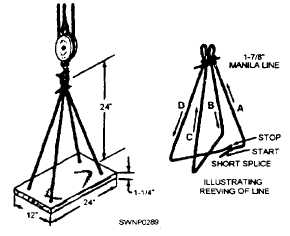
Figure 6-42. - A boatswain's chair.
long, 30 cm wide, and 3.1 cm thick). Make sure you always wear a safety belt when using a boatswain's chair. The safety belt should be attached to a lifeline secured to a fixed object overhead. Use a bowline to secure the lifeline to the person in the chair.
NOTE: A BOATSWAIN'S CHAIR SHOULD BE USED ONLY IF OTHER MEANS ARE NOT AVAILABLE.
Scaffold Safety
When you are using scaffolds, SAFETY is your NUMBER ONE PRIORITY! Failure to observe safety precautions can result in serious injury to yourself or coworkers. Some essential safety measures applicable to scaffolds are given here. Use each of them routinely. THINK SAFETY! Be a SAFE WORKER!
Structural members, support ropes, and scaffold equipment must be inspected carefully each workday before using them on the job. The use of makeshift scaffolds is strictly prohibited.
When personnel are working on a scaffold with other personnel engaged directly above, either the scaffold must have an overhead protective covering or the workers on the lower scaffold must wear Navy-approved, protective hard hats. The purpose is to provide protection against falling material. Where the upper working level is no more than 12 feet (3.6 m) above the lower, hard hats worn by workers on the lower level will satisfy this requirement.
An overhead protective covering consists of a roof of lumber, heavy wire screen, or heavy canvas, depending upon the hazard involved. The covering should extend a suffient distance beyond the edge of the scaffold to catch any material that may fall over the edge. A netting of screen should not be less than No. 18 gauge, U.S. Standard Wire, with a mesh not to exceed 1/2 inch. Screens of heavier wire or smaller mesh should bex used where conditions are such that the No. 18 gauge wire or 1/2-inch mesh will not suppl y adequate protection. Personnel should NOT be required to work underneath a scaffold. Scaffolds erected over passageways, thoroughfares, or locations where persons are working should be provided with side screens and a protective covering. A side screen is a screen paneling from the platform to an intermediate railing or from the platform to the top railing. Screening is formed of No. 16 U.S. gauge wire with 1/2-inch mesh. Screen is used for the purpose of preventing materials, loose or piled, from falling off the scaffolds.
A safe means of access should be provided to all scaffolds by means of standard stairs or fixed ladders. Additionally, ensure that a scaffold is properly secured against swaying.
Personnel should not be permitted on scaffolds which are covered with ice or snow. In such instances, clinging ice must be removed from all guardrails, then the planking sanded or otherwise protected against slipping. Workers should not be permitted on scaffolds during a storm or high wind.
No scaffold should be used for the storage of materials, except that required for the immediate needs of the job. Tools should be placed in containers to prevent their being knocked off and the containers should be secured to the scaffold by line. Always make a special effort to ensure that tools, equipment, material, and rubbish do not accumulate on a scaffold to the point where the safe movement of personnel is jeopardized.
NEVER throw or drop objects or tools from scaffolds. Handlines should be used for raising or lowering objects when they cannot be reached easily and safely by hand. Such things as jumping or throwing material upon a scaffold platform are to be avoided at all times.
Scaffolds must never be overloaded! Furthermore, whenever possible, see that the scaffold load is uniformly distributed and not concentrated at the center of the platform.
Wire ropes and fiber lines used in suspension and swinging scaffolds should be of the best quality steel, manila, or sisal. Manila or sisal line used as lifelines
Continue Reading